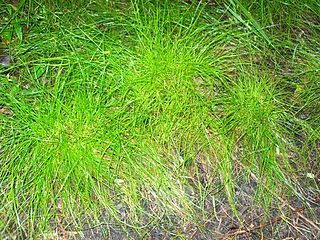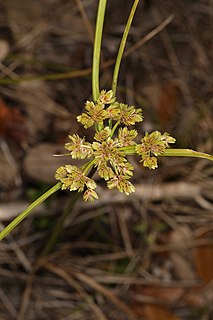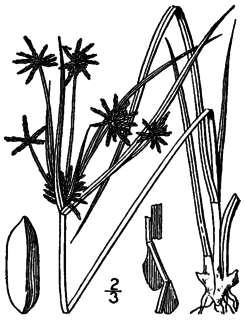
Cyperus is a large genus of about 700 species of sedges, distributed throughout all continents in both tropical and temperate regions.

Cyperus polystachyos, also known as Pycreus polystachyos, and also called manyspike flatsedge in the US, or bunchy sedge, coast flatsedge, many-spiked sedge or Texas sedge in Australia, is a herbaceous species in the family Cyperaceae, widespread in tropical and subtropical areas around the world, sometimes extending its range into temperate regions.

Cyperus eragrostis is a species of sedge known by several common names, including tall flatsedge, nutgrass, tall nutgrass, umbrella sedge, chufa, Earth almond, zula nuts, edible galingale and pale galingale.

Cyperus fuscus is a species of sedge known by the common name brown galingale, or brown flatsedge. This plant is native to much of Europe, Asia and North Africa from England, Portugal and Morocco east to China and Thailand. It is an introduced species in North America, where it is naturalized in widely scattered locations in the United States and Canada.

Cyperus odoratus is a species of sedge known by the common names fragrant flatsedge and rusty flatsedge. This plant can be found in much of the tropical and warm temperate world, including South, Central, and North America, Southeast Asia, some Pacific Islands, Australia, New Guinea, Madagascar, and central Africa. It is a plant of wet, muddy areas, including disturbed and altered sites. This species is quite variable and may in fact be more than one species included under one name. In general this is an annual plant approaching half a meter in height on average but known to grow much taller. It usually has some long, thin leaves around the base. The inflorescence is made up of one to several cylindrical spikes attached at a common point. Each of the spikes bears a large number of flat, oval-shaped spikelets. Each spikelet is usually light brown to reddish-brown and has a few to over 20 flowers. Each flower is covered by a tough, flat bract with a visible midvein. The fruit is a flat achene less than two millimeters long.

Cyperus squarrosus is a species of sedge known by several common names, including bearded flatsedge and awned flatsedge. It is found in wet environments in North and South America, Africa, Australia, southern Asia and Italy.

Cyperus laevigatus is a species of sedge known by the common name smooth flatsedge.

Cyperus iria is a smooth, tufted sedge found worldwide. The roots are yellowish-red and fibrous. The plant often grows in rice paddies, where it is considered to be a weed.

Cyperus gracilis, with the common name is slender flat sedge and slimjim flatsedge, is a sedge native to Australia. The species epithet gracilis refers to the graceful form of the leaves.

Cyperus articulatus is an aromatic species of sedge known by the common names jointed flatsedge and priprioca. It has also been known as Guinea rush or adrue. It grows as a perennial herb. It grows in water or near it in rivers, streams, lakes, and swamps with a hyperhydrate or possibly tenagophyte growth pattern. It is widespread across tropical and subtropical regions in Africa, southern Asia, northern Australia, the southeastern United States, the West Indies, and Latin America. While it is closely related to highly invasive sedges such as purple nut sedge, priprioca is less prolific and competitive than its relative.
Cyperus alopecuroides, commonly known as the foxtail flatsedge, is a sedge of the family Cyperaceae that is native to Australia.

Cyperus javanicus, also known as the Javanese flatsedge, is a sedge of the family Cyperaceae that is native to Indonesia and Australia.

Cyperus surinamensis, also known as the tropical flatsedge, is a sedge of the family Cyperaceae that is native to the Americas.
Cyperus zollingeri, commonly known as roadside flatsedge, is a sedge of the family Cyperaceae that is native to tropical areas of Australia, Africa and Asia.
Cyperus manimae, commonly known as the smoothstem flatsedge or the spectacular flatsedge, is a species of sedge that is native to an area of southern North America, Central America, and northern South America.
Cyperus meyenianus, commonly known as Meyen's flatsedge, is a species of sedge that is native to tropical areas of South America.
Cyperus amabilis, commonly known as the foothill flatsedge, is a species of sedge that is native to tropical and sub-tropical areas in the Americas, Africa and Asia.
Cyperus croceus, commonly known as Baldwin's flatsedge, is a species of sedge that is native to parts of North America, Central America, and South America.

Cyperus grayi, commonly known as Gray's flatsedge, is a species of sedge that is native to south eastern parts of the United States.

Cyperus hermaphroditus, commonly known as the hermaphrodite flatsedge, is a species of sedge that is native to parts of southern parts of North America, Central America and northern parts of South America.














